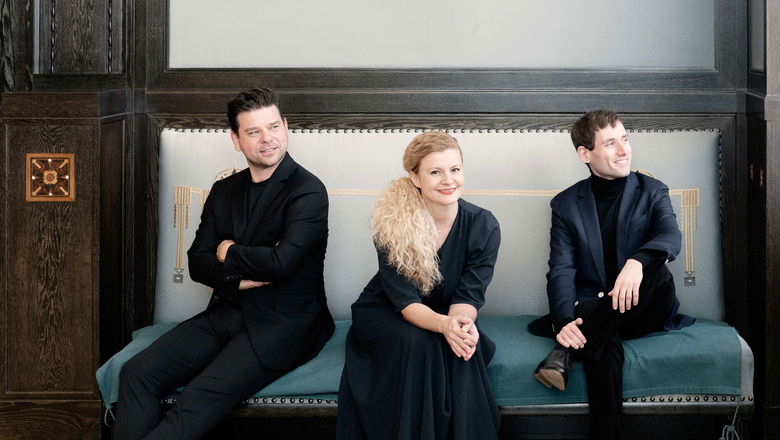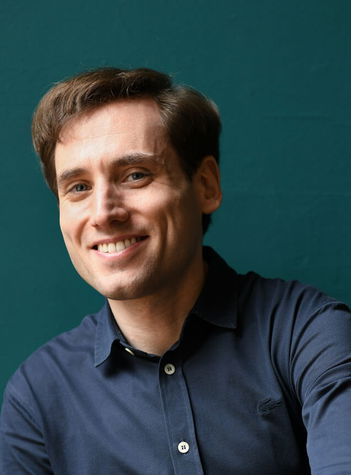Programme
Sergei Rachmaninoff
Trio élégiaque No. 1 in G minor (15')
Maurice Ravel
Piano Trio in A minor (25')
— Intermission —
Franz Schubert
Piano Trio No. 1 in B flat major, D 898 (45')
Secure your seat for the 2025/2026 season – presales are open.
Choose SubscriptionAt the first of three concerts planned by the curator of this year’s Series II, Peter Jarůšek, cellist of the Pavel Haas Quartet, we will hear three piano trios. Joining him will be his wife Veronika and Boris Giltburg, an Israeli pianist living in the Czech Republic.
Subscription series II | Duration of the programme 1 hour 45 minutes | Czech Chamber Music Society
Sergei Rachmaninoff
Trio élégiaque No. 1 in G minor (15')
Maurice Ravel
Piano Trio in A minor (25')
— Intermission —
Franz Schubert
Piano Trio No. 1 in B flat major, D 898 (45')
Veronika Jarůšková violin
Peter Jarůšek cello
Boris Giltburg piano

Boris Giltburg piano

The Moscow-born, Israeli pianist is lauded across the globe as a deeply sensitive, insightful and compelling musician.
He made his debut at the Dvořák’s Prague festival in 2019 and returned to the festival in 2021 as the curator of the chamber music series. He has performed with leading orchestras such as the Czech Philharmonic, Philharmonia Orchestra, Orchestre National de France, Santa Cecilia di Roma and WDR Symphony. He regularly gives recitals in the world’s most prestigious halls and has a long-standing collaboration with the Pavel Haas Quartet.
Giltburg has been exclusive to Naxos Records since 2015, releasing award-winning discs of a wide range of repertoire. In 2020 Giltburg recorded and filmed all 32 of Beethoven’s piano sonatas across the year, blogging about the process as it unfolded. The cycle was released on Naxos on all the major digital platforms and subsequently as a boxed set, with the complete Beethoven piano concerti to come (Royal Liverpool Philharmonic/Vasily Petrenko).
Giltburg engages audiences well beyond the concert hall. His blog “Classical music for all” is aimed at a non-specialist audience, and he complements it with articles in major publications and with regular streamings which attract a substantial audience.
Veronika Jarůšková and Petr Jarůšek violin, cello
Veronika Jarůšková and Peter Jarůšek are members of the Pavel Haas Quartet, an internationally acclaimed chamber ensemble that the violinist Veronika Jarůšková founded in 2002. The quartet appears at the world’s most important concert halls (London’s Wigmore Hall, the Musikverein in Vienna, the Concertgebouw in Amsterdam, the Elbphilharmonie in Hamburg, New York’s Carnegie Hall etc.) and has recorded nine albums that have won many prestigious prizes awarded by international critics (Gramophone Award, BBC Music Magazine Award, Diapason d’Or de l’Année etc.). The BBC Music Magazine listed the Pavel Haas Quartet among the top ten string quartets of all time. The cellist Peter Jarůšek is also in demand as a teacher of chamber music masterclasses around the world, and he will soon be working at such schools at the Royal College of Music and the Royal Academy of Music in London.
Together with their long-time friend and colleague, the Israeli pianist Boris Giltburg, Veronika Jarůšková and her husband Peter Jarůšek have gone beyond quartet playing in recent years, playing the piano trio literature as well. The result is a new ensemble of top-quality musicians who have already appeared at several prestigious international festivals (East Neuk Festival in Scotland, West Cork Music in Ireland, Schubertiade in Austria, and the Dvořák Prague Festival). In the coming months, the ensemble not only will give its debut concert at London’s Wigmore Hall, but also will record Dvořák’s complete piano trios on the Supraphon label.
Giltburg, Jarůšková, Jarůšek - evening programme
In the oeuvre of Sergei Rachmaninoff, pianist and composer in one person, chamber music pieces are to be found only sporadically. Of particular interest among them are two piano trios of the same title, Trio elégiaque No. 1 in G minor and Trio elégiaque No. 2 in D minor, both composed within a short period of time. The one-movement Trio elégiaque No. 1 in G minor was written in just four days in 1892. In its mood, it is linked to the tradition of similar elegiac works by Russian composers, especially by Pyotr Ilyich Tchaikovsky, who in 1882 honored the memory of his friend Nikolai Rubinstein with a piano trio dedicated “to the memory of a great artist”. When Tchaikovsky died in 1893, Rachmaninoff composed his second piano trio, using the title Trio elégiaque again, and using the same quote, “à la memoire d’un grande artiste” dedicated it to Tchaikovsky. As regards Rachmaninoff’s first piano trio, Trio elégiaque No. 1, it is not known to whom or to what its melancholy atmosphere refers. However, at that time Rachmaninoff was working on his first opera Aleko, based on Alexander Sergeyevich Pushkin’s short story The Gypsies, a tale of love, revenge and family honor with a tragic ending, and this may have been reflected in the trio. Melancholy, after all, was one of Rachmaninoff’s character traits. The high point of the sonata movement of Trio elégiaque No. 1, with its series of episodes, is a funeral march, which has an almost orchestral sound, and the trio is therefore sometimes described as a symphonic poem for three instruments. The work was premiered by Rachmaninoff himself together with his classmates, David Kreyn at the violin and Anatoliy Brandukov at the cello, on 30 January (11 February) in Moscow.
Piano Trio No. 1 in A minor is the only composition of its kind in the body of work of Maurice Ravel. Although he had been planning to write a composition for piano, violin and cello since 1908, he realized this idea as late as between April and August 1914 in the Basque commune of Saint-Jean-de-Luz, where he was from. Ravel himself described the work on this piece as an effort to take his mind off the war that broke out in July. In a letter to his friend, the composer and pianist Maurice Delage, Ravel announced his work with a self-deprecating humor: “I’ve written my trio. Now all I need are the themes.” The basic building block of the trio is rhythm. By its variability, polymetric character and asymmetrical division of bars, Ravel broke new ground in his work. On the one hand, the music opalesces in vague contours (the second movement, Pantoum, refers to a Malaysian verse form), while on the other hand it is organized according to the strict scheme of Baroque passacaglia (third movement). The rhythmic component of the final movement is reminiscent of the folk music of Ravel’s native Basque country. The premiere of the trio took place in January 1915 at the Salle Gaveau in Paris, the first performers being the Italian composer and pianist Alfredo Casella, the violinist Gabriel Willaume and the cellist Louis Feuillard.
Franz Schubert wrote four compositions for piano, violin and cello. After an attempt in 1812, left unfinished, he returned to this cast many years later in his Piano Trio No. 1 in B flat major, Op. 99 (D 898) and Piano Trio in E flat major, Op. 100 (D 929). However, the chronological order in which the two works were written was most likely reversed. Piano Trio in B flat major (the autograph is missing) was composed second and was published posthumously in 1836. The impulse for the composition of the trios was the founding in 1827 of an ensemble consisting of Ignaz Schuppanzigh (violin), Josef Linke (cello) and Carl Maria Bocklet (piano). All of them were friends with Schubert and were instrumental in the performance of several of his compositions. These two piano trios were rightly labelled “Grand” when first published. Piano Trio in B flat major features two characteristic aspects of Schubert’s music, the dramatic character and the romantic lyricism, presented in the first movement by the contrast of two main themes. Another typical Schubertian feature is the polarity of the key, applied in the numerous modulations of the second movement. The third scherzo movement uses the compositional technique of the canon, while its middle section consists of a simple trio. The final rondo movement is characterized above all by the variety of its rhythmic component. The trio was probably first performed on 26 December 1827 as part of a concert series organized by Schuppanzigh.
At the first of three concerts planned by the curator of this year’s Series II, Peter Jarůšek, cellist of the Pavel Haas Quartet, we will hear three piano trios. Joining him will be his wife Veronika and Boris Giltburg, an Israeli pianist living in the Czech Republic.